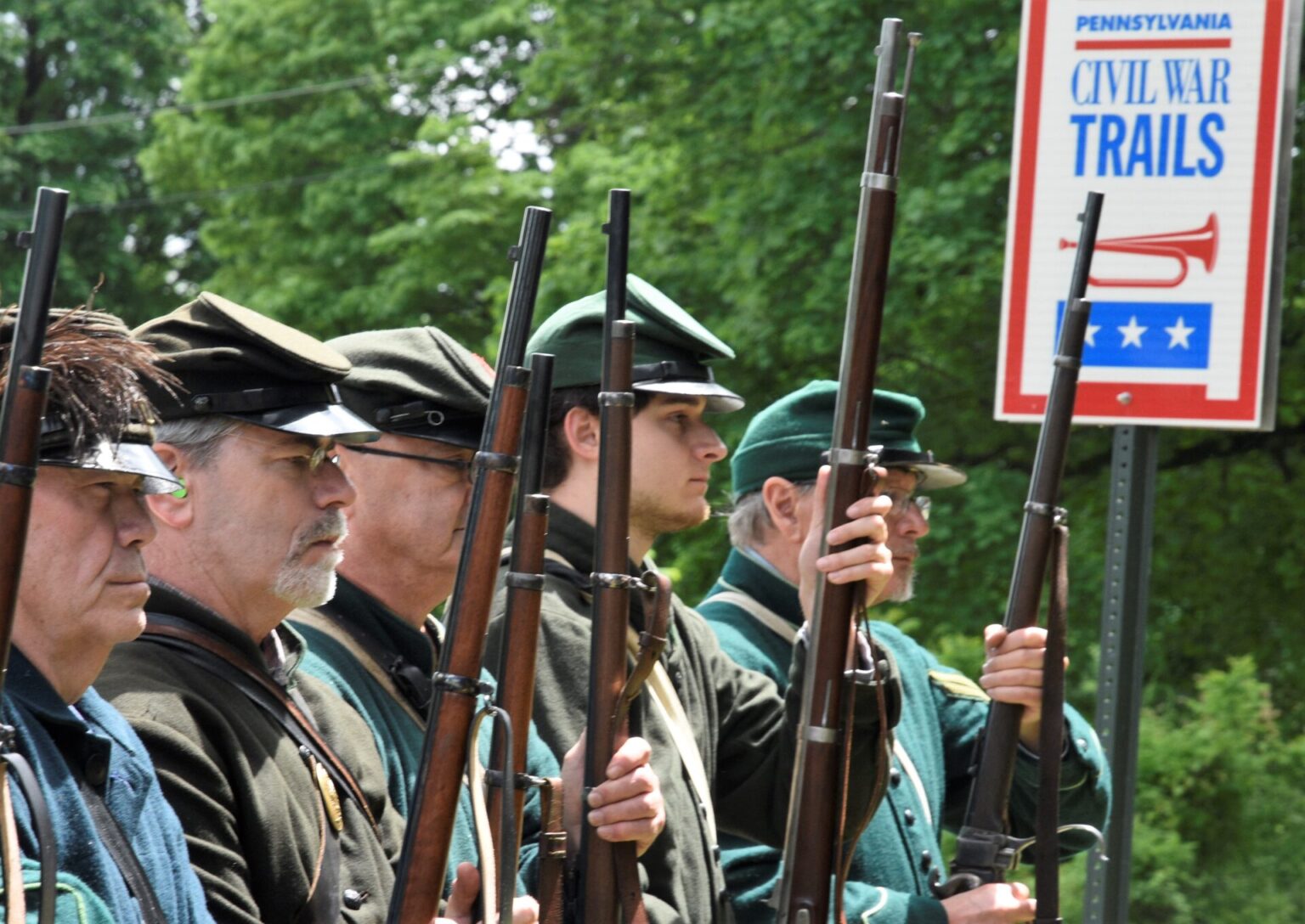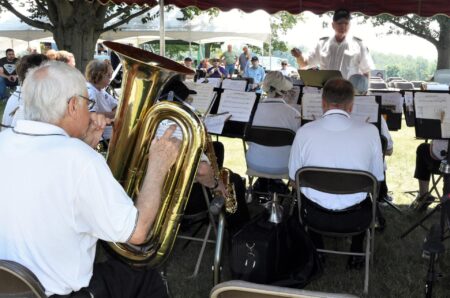During the American Civil War, most northern locales escaped the horrors of warfare that bloodied fields and demolished towns throughout the Confederacy. But one exception to this Union territory respite was Pennsylvania. Two of the state’s southern counties witnessed a trio of the conflict’s disastrous episodes during 1863 and 1864. Adams and Franklin Counties experienced first-hand terror when their communities and civilians found themselves trapped in the tempest of a tumultuous war.
General Robert E. Lee commanded the Army of Northern Virginia across the Mason-Dixon Line in late June 1863. His goal: to lead his men as far north as possible into enemy territory, create havoc, and force the Union government to negotiate for peace. But Lee never reached Harrisburg or Philadelphia. He and his 70,000 soldiers were drawn into a major battle at Gettysburg.
That epic fight produced gruesome results, with approximately 50,000 casualties. Gettysburg’s symbolic and strategic location made it one of history’s most important battles, with gigantic stakes for each army. During the three-day battle, the town was caught in the crossfire and Gettysburg’s inhabitants lived in constant peril. A twenty-year-old woman named Jennie Wade was killed in her kitchen when a stray bullet invaded her home on Baltimore Street.
At the battle’s pivotal culmination, General Lee made a tactical error. His army had previously fought and won with inferior numbers and bold tactics, but at Gettysburg rebel soldiers could not take the Union high ground that Lee desperately wanted. Confederate troops were repulsed and decimated. General Meade’s Yankee soldiers emerged victorious, and a stunned Lee had only one remaining option: retreat.

Escaping with a massive and wounded army was a tremendous logistical challenge. Lee split his remaining 50,000 men into two columns, with intent to reach Williamsport, Maryland, and then cross the Potomac River into safe territory. These wagon trains reached over twenty miles in length- it was impossible to hide movement of that much material and men. One local said those wagons rumbled by his home for several days with no break between them.
One chosen Confederate escape route was through Fairfield Gap and then up over the Appalachians at Monterey Pass. The road was easily navigable during fair weather. On July 4, 1863, a snaking Confederate column traveled toward the pass. A young local woman noticed.
Her name was Henrietta Zeilinger, a seventeen-year-old girl who lived on a farm near the summit. Unlike most local residents- who withdrew from the invaders- ‘Hetty’ kept her eyes fixed on the rebels. As the weather worsened and a deluge of rain fell, the mountain road turned into a quagmire.
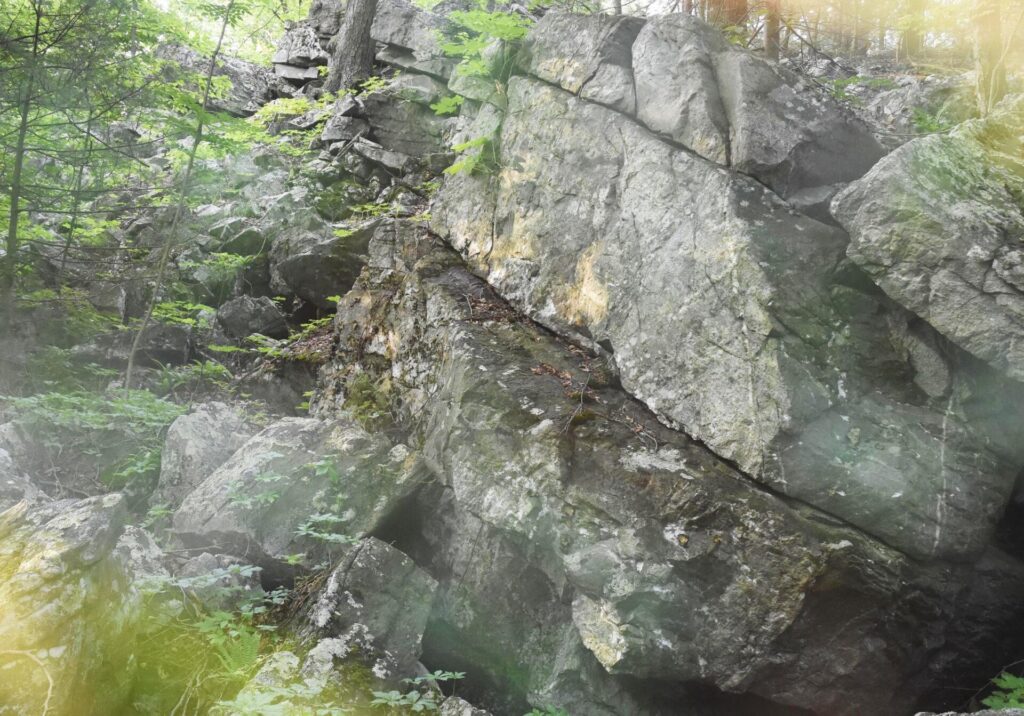
Union soldiers appeared next, under the command of General Kilpatrick. They chased the rebels, trying to disrupt their retreat. Hetty met them with a warning. The Confederates were positioned ahead with a cannon pointed toward the Yankees.
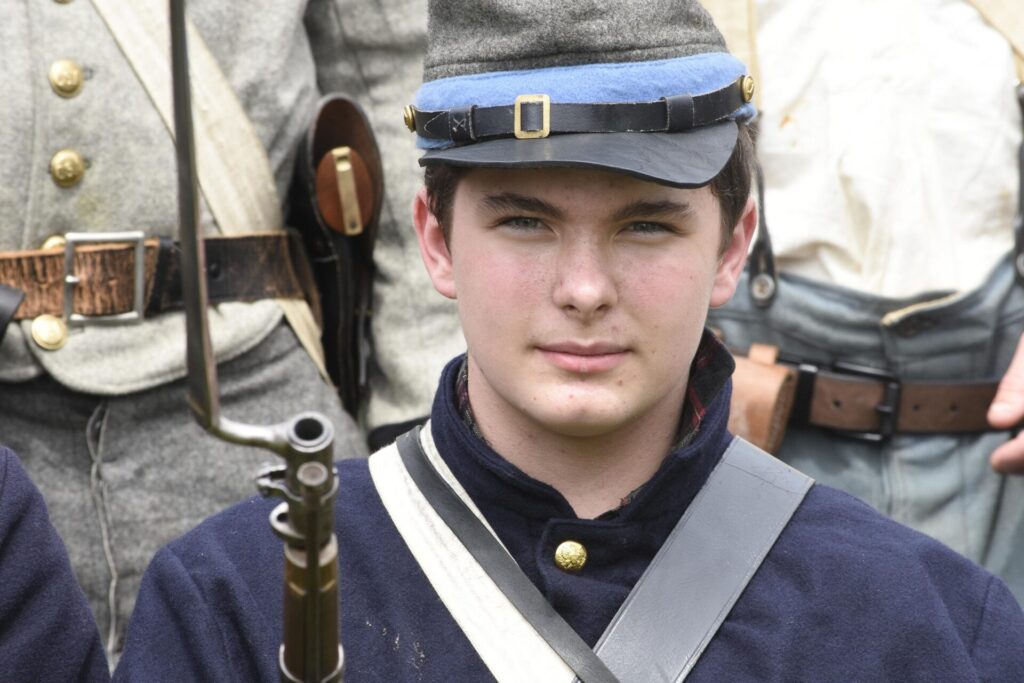
On May 11th, 2024, 161 years later, Hetty’s bravery was honored as a Civil War Trails commemorative sign was dedicated, celebrating her moment of glory at Monterey Pass. The dedication took place at Charmain and Furnace Roads, a short distance from the battlefield.
While exploits of the soldiers at Monterey Pass have been discussed for years- famous military men like George Armstrong Custer were present for the clash- this modern-day event recalled the actions of a spirited young female. A group of local historians, Zeilinger descendants, and Civil War enthusiasts gathered to hear speeches and inspect the new sign, which stands in a peaceful grass triangle along the roadside. The title for the dedicated sign read: ‘Eyes in the Dark’.
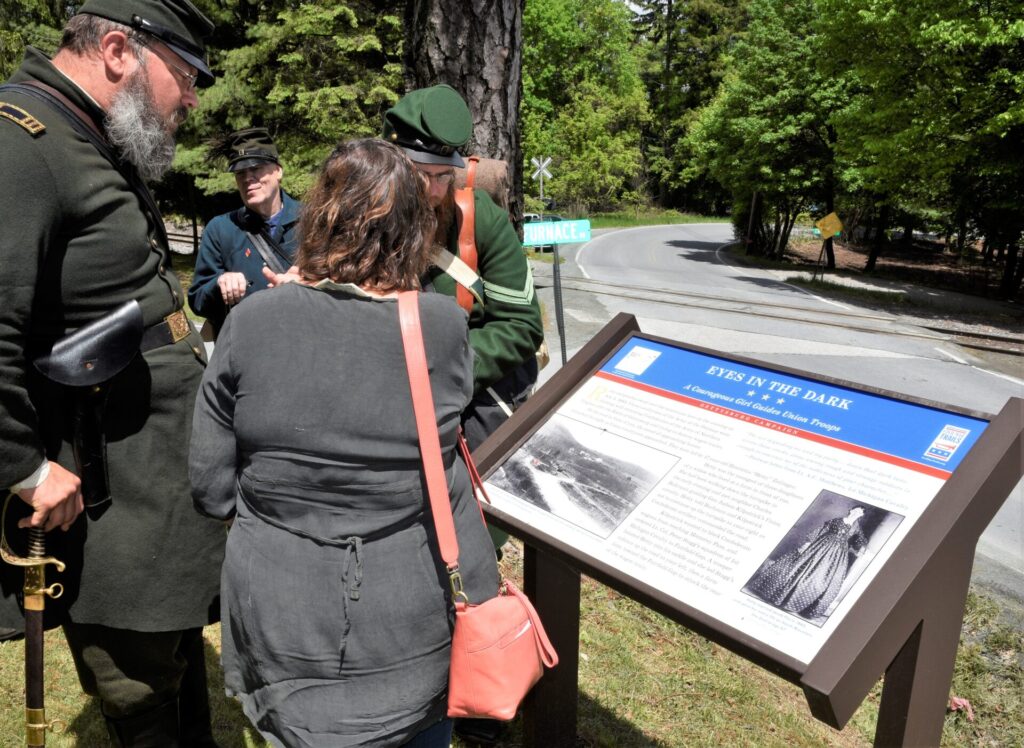
Civil War Trails (CWT) is a non-profit organization that promotes historic education with a community driven approach. They collaborate with local historians and family descendants to research and record the past. Since 1994 the group has interpreted 1200 Civil War sites in six states, telling many untold stories of unique events, people, and places. This ‘Eyes in the Dark’ sign is the latest CWT interpretive milepost denoting the Gettysburg Campaign.
Lee Royer, President of Friends of Monterey Pass Battlefield, offered the ceremony’s opening comments. “We’re really proud of this young woman,” Royer said about Zeilinger. “I consider her a heroine.” Royer then introduced historian John Galie, who presented a brief talk about the battle and significance of the sign that honored Hetty Zeilinger.
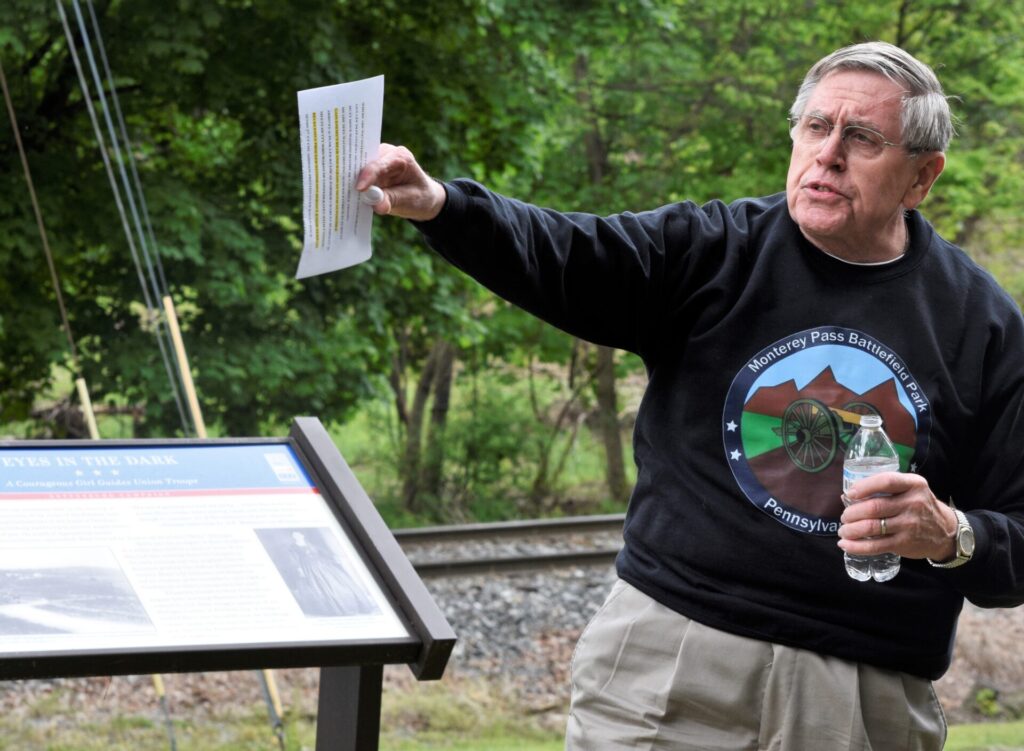
Galie highlighted the chaotic and confused fighting at Monterey Pass, which took place after midnight in a raging thunderstorm. In total darkness during torrential rain, only flashes of lightning or a gun’s blast offered enough illumination to spot the enemy. Despite these dangerous conditions, Hetty Zeilinger was hoisted into a soldier’s saddle and helped guide the Union army.
One notable section of this new sign highlighted a quote by Lt. A.E. Mathews from 1st Michigan Calvary, who remembered Hetty’s valor in a letter later written to Zeilinger. “The act of guiding me and my party…down that dark lane, across the creeks, alone among rough and strange soldiers is enough to convince me of the nobleness of your character.”
Historian Galie also recounted the long life of Miss Zeilinger, who married two years after the Monterey battle, to a man named Jacob Fitz. Together, the Fitz’s raised seven children, enjoyed 25 grandchildren, and had 25 great-grandchildren. Hetty Zeilinger-Fitz lived her entire life on South Mountain, and died on October 20, 1932, aged 87. She is buried nearby at Adams County’s Fountaindale Union Cemetery- her weathered headstone stands upright with simple dignity.
As the ceremony concluded, the green-clad Company C, 2nd United States Sharpshooters, who led a weekend-long encampment and demonstration at the battlefield, gave Hetty a fitting military salute, firing their weapons.
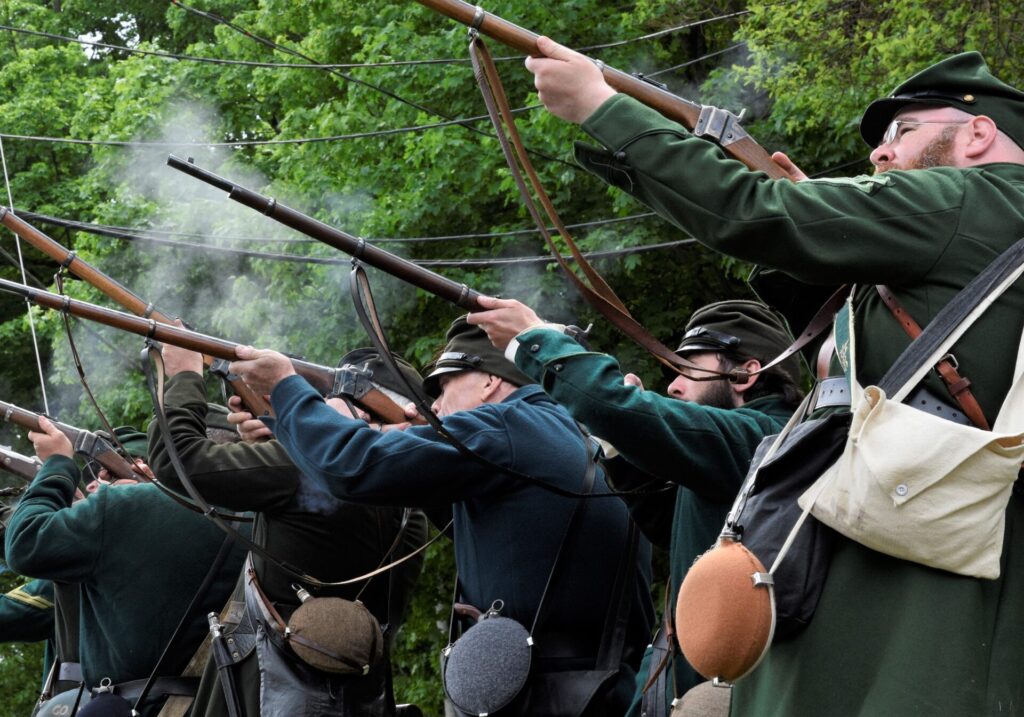
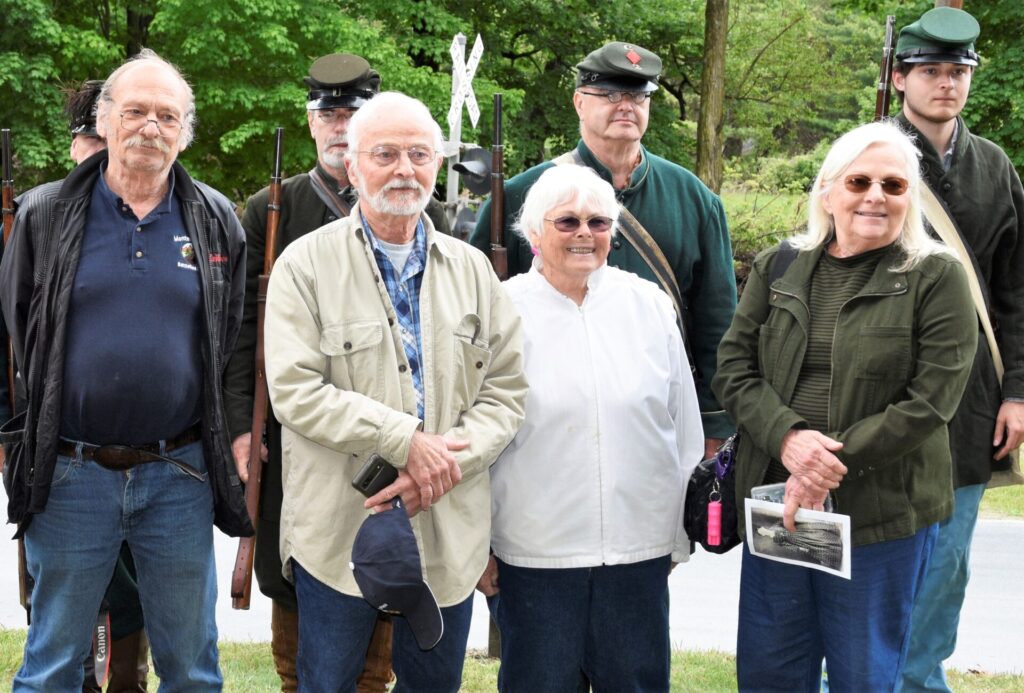
Descendants of Miss Zeilinger-Fitz were also present for the ceremony. Like the soldiers many years before them, they traveled a long road to reach this scenic spot. Ray Zeilinger, his daughter Doree, along with Gary and Marilyn Zeilinger, drove from Nebraska, a 1200-mile journey, to witness the unveiling. They posed for pictures with Civil War reenactors next to the new sign. “We learned about Hetty five years ago and discovered we’re related. We wanted to be here on this special day,” Ray said.
Ray Zeilinger also provided the only known portrait of Hetty Zeilinger, which graces the sign, showing a proud young woman in period dress. Her portrait exhibits the aura of a young lady who met life’s challenges with calm confidence.

At the conclusion of the 1863 Monterey Pass battle, General Lee and his long wagon columns survived Union harassment, reunited, and reached the Potomac. Swollen by heavy rain, the river was uncrossable for a spell- the Army of Northern Virginia was temporarily trapped. Had General Meade’s aptly named Army of the Potomac aggressively attacked the Confederates, he might have crushed his southern enemy on the river’s Maryland shore. But Lee eventually escaped into Virginia and regrouped to fight another day.
One year later, rebels under the command of Jubal Early invaded Franklin County. They held Chambersburg for ransom. When the community failed to pay the $500,000 bounty demanded, the Confederates burned the entire town. In similar fashion to earlier Gettysburg and Monterey Pass residents, Chambersburg dealt with the destructive force of an enemy invader.
Today, the Friends of Monterey Pass Battlefield have devotedly preserved the historic 125-acre battleground near Blue Ridge Summit. The group sponsors various programs throughout the year, including a battle reenactment, cultural events, and they host relics and interpretive information inside an attractive museum. They are also negotiating to include a Toll House property in the park. Well-marked trails allow visitors to explore rugged terrain where the memorable Civil War battle occurred on a stormy 1863 night.

The addition of Hetty Zeilinger’s story enriches the Monterey Pass interpretive legacy by telling a tale not about typical military tactics or weaponry, but a young civilian’s courage. Historian John Gaile, who leads tours at the battlefield, summed up the commemorative sign event. “Hetty had been lost to history for quite some time, but through efforts of her family, Civil War Trails, and local historians, we can now share our appreciation for this brave young woman.”


